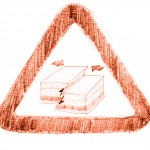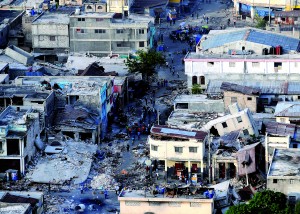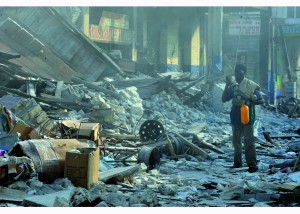MONDAY, 3 MAY 2010
It is predicted that in our lifetime we will observe the deadliest earthquake on record, with potentially over one million fatalities.Over the last decade alone there have been many devastating earthquakes. The 2003 Bam earthquake in Iran resulted in 30,000 deaths. The 2004 Sumatra earthquake and resultant tsunami killed at least 230,000 people. In 2008, 88,000 people died as a result of the Sichuan earthquake in China, and the recent earthquake in Haiti caused 230,000 fatalities. With several urban populations such as Tehran and Istanbul rapidly expanding on major active fault systems, these statistics are forecast to get worse. However, with improved understanding of earthquake behaviour, this need not be the case.
The study of earthquakes is an increasingly fast-moving field thanks to the development of space-based technologies, such as Global Positioning System and Synthetic Aperture Radar Inferometry, which allow millimetre-scale surface deformations to be observed. This has greatly improved geologists’ understanding of the earthquake cycle, the repeated sequence of crustal strain accumulation and release. The two processes act on very different time scales. Strain accumulates slowly due to the differential motion of crustal segments across a locked fault. This causes a long-term build up of elastic energy until the fault can no longer take the strain. The elastic energy is then suddenly and catastrophically released, rupturing the fault and generating a variety of seismic waves, which we experience as an earthquake.
These processes can be monitored today in real time, but past earthquakes can also be analysed by excavating trenches and dating disrupted horizons, revealing how often earthquakes have occurred and how far fault lines have moved over time. Bringing all this information together, geologists can learn about how and when landscapes have evolved, and understand more about active earthquake zones. Crucially, geologists can use such information to comment on both the size and likelihood of future earthquakes for a particular area.
Broadly speaking, earthquakes only occur in the upper crust, where rocks are cool enough to behave in a brittle manner. At greater depths, rocks are closer to their melting temperature and deform gradually by flow in the solid state. This puts a limit on the depth of faults and, since earthquake magnitude is proportional to fault area, the lateral extent of a fault indicates a maximum magnitude. Predictions about future earthquakes can be made by observing for how long and how rapidly a fault has been accumulating strain. Combined with knowledge of the characteristic maximum strain a fault can accommodate, important predictions can be made.
However, these predictions are at best on the timescale of decades, and accurate earthquake prediction remains elusive. The focus instead needs to be on preparing for earthquakes, using knowledge of when, where and how large the earthquake may be, in order to direct resources appropriately. The question is therefore what causes the majority of deaths from earthquakes, and what can we do to prevent this?
When earthquakes occur under water, the main hazard comes from the generation of a tsunami. Earthquakes known as megathrusts occur at plate interfaces where one plate moves below another. These produce the largest magnitude earthquakes in the world due to their huge fault area. If the megathrust causes a displacement of the sea floor then the water, being effectively incompressible, is also displaced with a wavelength comparable to the fault width. Crucially, if this wavelength is much greater than the sea depth then a tsunami is generated, since the resulting wave behaves in a non-dispersive manner, travelling with a speed proportional to water depth. Once this wave reaches shallow depths, it increases in size, forming a large amplitude wave such as that witnessed around Sumatra on 26 December 2004.
The catastrophic devastation wreaked by this earthquake led to calls for the widespread (and costly) installation of early warning systems. However, many megathrust earthquakes do not result in tsunamis; the rupture dies out below the sea floor, typically due to the presence of sediment piles and clays that act as barriers, stopping rupture propagation. An early warning system could therefore lead to a ‘cry wolf’ situation. They clearly have some use, but are not a silver bullet.
Perhaps more important is to educate people to recognise the hall-marks of an impending tsunami, such as a large earthquake followed by a receding water line, and to provide adequate escape routes. Several stories of survival from 2004 attest to this, with islands with a folklore tradition of tsunami identification experiencing far fewer casualties.
On land, the biggest killer from earthquakes is man-made: the collapse of buildings and subsequent suffocation or crushing. Earthquakes produce a variety of waves; those containing shear motion are the most destructive for buildings. The damage caused to buildings is strongly dependent on their proximity to the epicentre, as seismic energy is inversely proportional to distance squared. The response of the building to shaking depends on the fundamental period of vibration of the building, which is related in part to its stiffness. Seismic waves with periods similar to that of the building will cause resonance. A large portion of earthquake energy is ‘short-period’, which resonates with stiffer objects. Therefore, these either need to be made more flexible, or stronger. The technology to do this has already been developed and can be easily applied to new builds. This includes foundations that can move independently of the building, thereby reducing the destructive lateral shaking motions, and structural reinforcement. Far more problematic and expensive is retro-fitting older buildings to make them safe.
Again and again we observe high death tolls in earthquake-hit places where construction is inadequate: the 2003 earthquake in Bam, where local buildings were made from mud-bricks; the 2008 earthquake in Sichuan, where multiple schools collapsed due to poor workmanship; and the 2010 earthquake in Haiti, where the incredible poverty of the area and the use of poor building materials exacerbated the devastation.
While the death count is still being confirmed, it is thought that the Haiti earthquake is one of the deadliest earthquakes on record. Seismically active regions, such as Japan and California where building codes are more stringent, would not have suffered anywhere near this level of devastation for an earthquake of the same size.
Ultimately, it is not earthquakes that kill, but poorly constructed buildings and a lack of education. Both of these are rectifiable. Geologists can do their part in deducing where earthquakes are most likely to occur, but in the end it is the responsibility of individual governments to improve education, enforce appropriate building regulations and support retro-fitting projects. However, with earthquake recurrence intervals being far greater than political terms, this will require a seismic shift of its own in the mindset of politicians.
Owen Weller is a fourth year Natural Sciences Tripos student in Earth Sciences



